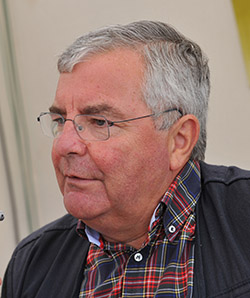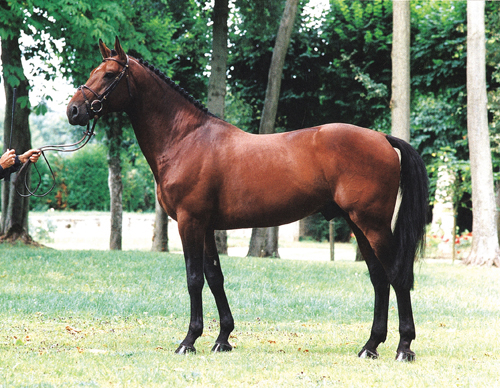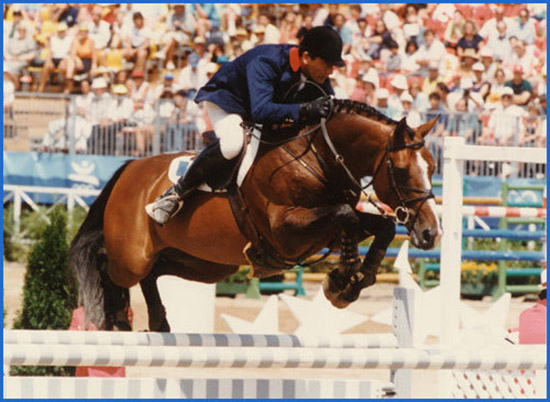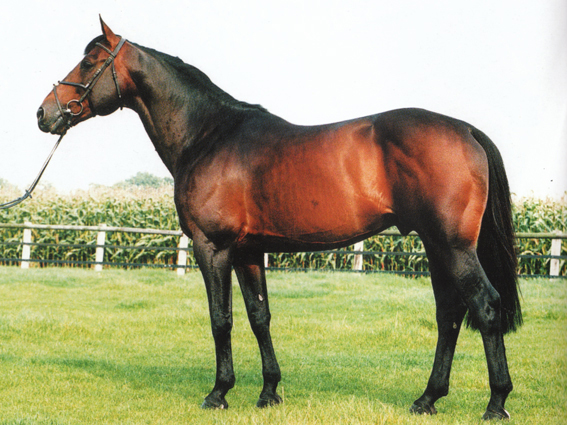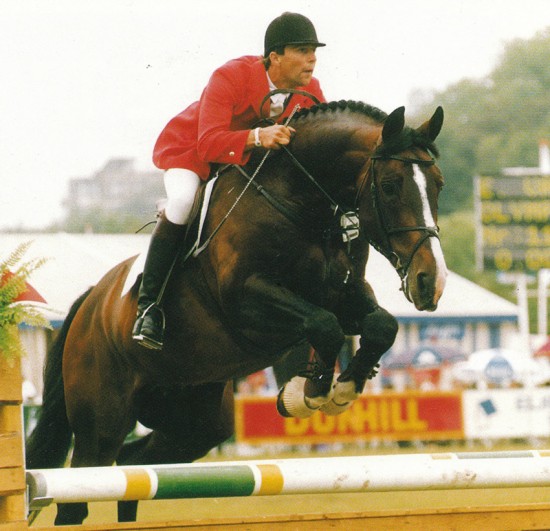Arnaud Evain is one of the most influential players on the French jumping scene. As a promoter, an author, an organizer, a breeder and a rushing river of creative ideas.
When Arnaud speaks, it is wise to shut up, sip your wine, and listen. Luckily for all of you, I remembered to switch on my little digital recorder, so you can share the experience.
“We have been measuring conformation in France with a new system with markers on the horse’s body, then measuring the movement with a series of cameras, so that you can digitalise information. They started three years ago, and they are trying to find a relationship between conformation and performance. They have done that now with three crops of young horses, with the 30 top horses in France.”
“The two amazing things that come out of the first batch of data, is that while in the past riders always wanted short boned horses, horses that were low in the knees and strong bones – you can forget about that, long bones are okay. And very surprising, horses that are a bit downhill will go a little better because it is easier for them to go through, being built a little downhill is alright for jumpers!”
A discussion of a stallion very dear to his heart, Cabdullah (why not, Arnaud bred him using frozen semen from the Olympic silver medallist, Abdullah) turns quickly to the debate between producing for the professional or the amateur rider:
“Cabdullah has had a very good year in regards to his progeny. We have retired him from international competition – now that he has won over 150 ribbons in international competition and he is 13 years old, that is enough. He is going to breed more and more because his progeny are going very well. Every year, Cabdullah’s progeny break a new record – this year he was the sire of Istom, the 7 year old stallion champion, Kildare was third in the 5 year old championships. I think he was the only stallion to sire two medallists at the one championships!
He is breeding very careful horses, and very rideable horses. Perhaps he is not the sire for eventing horses, unless you are sure the mare will pass on a good trot – the trot is not his strong point. His gallop is wonderful, and his progeny have such an easy gallop that they canter instead of going to extended trot.”
Fetiche du Pas
Arnaud is also excited about the progeny of another of his ‘stable’ of stallions, Fetiche du Pas:
“This year is the first year we saw the progeny of Fetiche du Pas – he is of the combination Le Tot de Semilly and Almé, along with two Thoroughbreds, Night & Day and Furioso. Fetiche was himself the French Six Year old champion, and he was starting a very promising career when he had a very bad car accident. The lorry was destroyed, and Fetiche was left alone on the motorway and started to gallop in amongst the vehicles. He tried to jump the barrier in the middle of the motorway, and ended up upside down in the middle.”
“The rescue team came and decided to kill him. The vet was called and luckily recognized him, and said ‘no it is Fetiche du Pas.’ The vet performed a miracle and got him out and the next day he was walking! One year later, he is competing again with an amateur.”
“This year was the first year for his progeny, and he had five finalists at Fontainebleau in the 4 year old championship, and two of them were considered very promising. He gives his progeny a lot of energy – he is twice Warmblood but I would not be surprised if he sires a good Three Day eventer, his stock are willing horses, they want to go. He might not produce as many good amateur horses as Cabdullah, we’ll see – but Fetiche is going to have some champions that is for sure.”
“Some stallions like Cabdullah will maybe produce some champions but he will certainly produce many rideable horses. Some stallions like Baloubet du Roet they will produce horses with amazing energy, but not all amateurs can control that energy. It’s like me driving a Ferrari, I might make a couple of mistakes and damage my Ferrari before I am really able to drive it.”
Despite the fact that the French have been over the past 50 years probably the most successful breeders of jumping horses in the world, there has been very little information about the French system or French horses, in Australia. Interestingly, it is our riders who in search of jumping success who are seeking out French blood, leaving the breeders to catch up with them.
Arnaud’s dry humour comes to the fore when discussing the state of the French horse breeding industry:
“It’s hard to be able to talk about a breeding program when you have a boat with 8,500 pilots on board. It is difficult to have a specific direction in France, but we have a general direction and you can see in the history of France, one of the major reasons that French breeding is appreciated in the world today is because of Thoroughbreds.”
“We used the proper Thoroughbreds, the bad ones we used also, but no-one remembers them, they disappeared from the dam lines. Now if you go into the pedigrees of the French book, and you find stabilized horses with between 15 and 20% Thoroughbred blood – the situation is much the same in Holland – and when you mix those horses together you keep 15-30% Thoroughbred.”
“The use of a new Thoroughbred was a must fifteen to twenty years ago when you had to select the good bloodlines and keep adding ‘blood’ into the heavy horses. The heavy Dutch horse carrying the milk in the country, the heavy Holsteiner, the heavy Hanoverian, if you see the pictures of the stallions from the 50s in all the studbooks, they were big horses.”
“It was similar in France. The dam of Almé, she was working in the field. She was by a Thoroughbred, but her grand-dam was a very heavy horse, and she was doing a job in the fields, and having a foal at the same time! But now we have these good Thoroughbred bloodlines we have kept in the French breed – Furioso, Rantzau, Diavolo, I can name ten that provide 90% of the quality. Go to Germany and you will find Ladykiller, Sacramento Song, another group of ten. But now we have them – if take a drink with 20% alcohol and mix it with another drink with 20% alcohol, we still have a 20% alcohol. The same with our horses, we can breed the horse with 20% to another with 20% and keep the percentage we need.”
“We have to be very careful adding a new Thoroughbred, if he is a good one that is a bonus, but a bad one that is a problem – and both ways takes 20 years to work itself out. In the market you will find very few breeders who will take the risk of a new Thoroughbred because you can’t sell foals by a Thoroughbred – only when you can prove what they can achieve. If it is wrong it is a total disaster. Breeders are becoming more and more careful with using Thoroughbreds,”
“I think it is a shame because new genes would be helpful. We keep using the blood of the same 15 Thoroughbreds, it is not inbreeding because they are a long way back in the pedigrees, they are good, they have been the base of our bloodlines. A good new one would be helpful, but we don’t need them as much as we needed them 20 years ago because we have already about 20-30%. But if you know a very good one I am interested in it…”
“You have horses today in competition, with no Thoroughbred in the first three generations, but they have a lot of blood. Thoroughbred does not have the exclusivity of blood any more. Take Quidam de Revel, if you look at his pedigree it is quite cold blooded but he has one Thoroughbred in the third generation which is pushing blood all through the pedigree.”
Quidam de Revel
“Or you can find cold Thoroughbreds, the names won’t mean a lot to you because they haven’t produced much. They are 100% Thoroughbred but they are cold horses, they are slow thinkers. What you expect from a Thoroughbred is a quick thinker. As a rider said to me once – a short distance between the legs and the brain. The horse can have a long neck or a short neck, but it has to be a short distance between your legs and hands and his brain – that’s what we call ‘blood’.”
“In the 70’s only the Thoroughbreds had that quality – now we have a lot of Warmbloods with the same quality. A good Thoroughbred is wonderful but who is going to pay to detect him.”
“There are breeders like Ferdinand le Redde who is courageous enough to buy a steeplechaser in Pardubice in the Czech Republic, and he will try with 10 mares, and if it doesn’t work he gets rid of the horse and the babies. He can do that because he has the name, he puts the stamp ‘Rouge’ on the horse and someone will buy.”
“A good Thoroughbred would be very useful, but tell me where it is – because I won’t take the risk myself. And to improve the average level of mares we have today, with a Thoroughbred, he must be a much better one than 30 years ago.”
Was Julio Mariner, the English derby winner who came to Holland as a jumping sire, a success?
“He was one of the good ones but you ask Jan Greve how many other stallions he had to try first. Jan told me, if he was the head of the Dutch Studbook, he would oblige the breeders to try a new Thoroughbred every five years so that we can find a good one every 20 years. If Jan has added something to the Dutch breeding, it is thanks to this philosophy, but he doesn’t make a fortune. Very few people are in the position to try like that. Breeders like Jan Greve, or Weipke van der Lageweg, they can experiment. Last time I almost brought a Thoroughbred back from New Zealand… it’s difficult. We can survive without it, which was not the case twenty years ago.”
Arnaud has been quietly building a base in New Zealand over the past decade:
“We started eight years ago a breeding program with John Cottle, David Kirk and Warwick Hanson, with semen from French stallions and Thoroughbred mares. We started with 20 different Thoroughbred families, and I said I won’t come for the first five years. You breed them, and I will ship you some semen, and after five years it was a terrible day, when we decided that out of the 20, we kept three mares and we eliminated all the fillies out of the ones we rejected. We could have said, let’s try another generation with the fillies but I think that would have cost us at least five years.”
“We concentrated on the three, and I hope that within ten years we are going to be able to produce out of those three dam lines, some really good horses. We decided to import five fillies from France to improve the chances – those fillies were at 20-30% Thoroughbred, already selected and mixed into a good result.”
Arnaud has been influential importing semen from Holland into France, traditionally not a market prepared to allow outside blood:
“Today the foreign stallions are 15% of the market, and 15% of the breeders are breeding something other than Selle Francais. The grass is always greener outside…”
Which stallions?
“I chose to use Dutch stallions, because first of all my Dutch is far better than my German, and also I think the Dutch have already made a big step – they did not exist 40 years ago.”
“They mixed a bit of Thoroughbred, quite a lot German blood and French and a bit of Belgian, and they made a commercial success out of that. More importantly when you see the progeny of a German stallion in Holland you have a better idea of what he is going to produce with a French mare, than you do with a German stallion in Germany. Especially the Holsteiner – I don’t know much about the Hanoverian, and that is my fault – but there are not many Holsteiners that will go well with the French mares because the French herd of mares is very different from the Holstein herd. It is the same the other way, the most successful French stallions in Germany – I don’t think they would have been so successful in France.”
Quick Star
“If you see a stallion like Quick Star, he makes tremendous horses in Germany with Holstein mares, in France he makes more normal horses. Just be careful. When you have a nice cocktail and you say, it would be good to mix it with a bit a hot water, maybe the temperature will ruin the perfume of your cocktail.”
“If I see a pure Holstein in Germany I am still not sure about the stallion, but if I see him in Holland with Dutch mares, I am able to say to French breeders that he will work with this type of mare, but not with that type.”
“Burggraaff has been successful for us because we can say to breeders, avoid giving him to leggy mares, avoid giving him to mares with a sour back… breed him to that kind of mares and he will fit well.”
“If I import an Australian wine, then it has to be a special one. We have a lot of wine in France and it is nice to have a very good Australian wine – but it is not worth drinking a normal one. If I go to Germany or Holland as a breeder, I don’t want to use a normal stallion, I want one that is going to add something I didn’t have – and make me a new stallion so I can beat those Dutch people in the next generation.”
Concorde
“Concorde is an interesting stallion for us, he brings qualities that are useful in the French mares – agility in the hocks, activity behind. The two major qualities we have to improve in the French horse, is a bit of a better mouth and looser gaits. Sometimes our horses get contracted easily. That is why we are using imported blood – plus we like to follow the fashion, breeders have to sell foals. If they want For Pleasure because it will sell well, then I will get them For Pleasure – even if I think there are twenty horses in France at least as interesting as For Pleasure.”
“Partly we follow fashion, partly we try to add value to the French herd by using stallions that are known for their progeny. If we have to take a risk on a young stallion, we’ll take a risk on a young French stallion because we know more about his mother line.”
“It’s difficult because it is a mix between the technical attitude of improving the genetics, which only counts for 20% of the final result – and the commercial attitude which says a baby by this stallion will sell well because the owner will buy it back. A lot of breeders are thinking, not who will ride my foal but who will buy my foal, and that is a short term attitude – we must breed horses to be ridden.”
France has been a pioneer when it comes to using frozen semen – what is the proportion of frozen used today?
“About 30% with frozen semen, 40% chilled and 30% natural service – old fashioned but it works, but it is going less and less.”
The stallions, are they state owned or privately owned?
“55/60% private – 35/40% national stallions. The National Studs have a policy of buying very good young stock and they have a very good network, right around the country, and they don’t make the breeder pay the right price, it is a pretty good argument – good horses spread all over the country and at half the price they should cost,”
Do the French breeders breed for the amateur or elite market?
“They breed for the Olympics and sell to whoever wants to buy. That’s our Mediterranean temperament. More and more are breeding for a rideable horse. That was my interesting problem in the young horse classes I judged in Australia – should I give a better score to the one I would recommend Eduard Couperie to come and look at for the next World Cup, or to the one which is going to make the nicest 1.40 for an amateur? Which do you think? If you ask for the horse for my daughter to ride, or for Eduard to ride – they are both good clients – but the selection is not the same.”
“To bridge this gap we are trying to create a 1000 day program, where an amateur can buy a 3 year old and brings him up to being a nice six year old, with the help of a professional for one week every month. This is a program where they can phase by phase, build a horse. It is much too expensive to have an amateur horse made by a professional rider. An amateur likes to have a horse they can do something with… 80% of the competition is amateurs, people who only ride twice a week.”
How do you buy horses in France – we have been robbed in every country in Europe, what is the go in France?
“It is different if you are an amateur. If you are an amateur coming from overseas, then I would recommend you go to a professional horse dealer. If you are an amateur, then in 99% of the cases you are going to run into a problem with your horse – even the best horse in the world – and you are going to need someone to fix it. I have a very good German car, but still every 15,000 kilometres I take it to the garage. Breeders will kill me for saying this, but if you are an amateur, don’t buy the horse direct from the breeders, go to somewhere you can get after sales service, because if you are an amateur you will need it even if you buy the best horse in the world.”
For breeding stock – should we go to the farmers or auctions?
“Auctions are not so bad. Altogether there are about 750 horses a year sold in French auctions, so that is about 10% of the births, so what goes to the auctions is within the top 25% of horses of the highest quality. If you want breeding stock you will probably find them at an auction. But go in a professional way, go to see the horses at the stable, watch the vets’ reports, if you do all that properly then the auction is the best way to make a good deal – but you have to be professional. You have to make a decision, I have this budget, up to this amount I will go and no further – we as auctioneers will try, ‘come on 10% more and you will have it’. We are helping the breeders sell their horses… but the rest of the year we are saying to the breeders, put a low reserve price to help us sell. We love our breeders and we love our clients. It is consistent in our auctions over the last ten years, I write down the price I think the horse will go for and 60% of the time I am right, when I am wrong it is equally 20% higher, 20% lower. That is why a sale is a good chance for everyone, but more for the person wanting breeding stock, or a professional.”
Do you get X-ray reports at a French Auction?
“Of course. Too many, sixteen per horse.”
Is OCD a problem?
“It is a large opportunity for the veterinary profession to make money. OCD is a problem, but lived with OCD at a fairly high level until we discovered how to read it on the x-rays. We now know quite well how to fix it. Less than 20% of OCD cases becomes a problem, and in the majority of those situations, surgery can fix the problem.
Back in the 70s we were talking about navicular, but thanks to the farrier, thanks to our feed suppliers and our vets, we have been able to live with that. If OCD had been a key point in the selection, you would never have heard of Ramiro, never heard of Almé, nor of Jalisco or any of those good stallions.”
Are stallions in France rejected on the basis of their x-rays like they are in Holland?
“No – and the Dutch will abandon that system eventually, it is just marketing. The Dutch will privately tell you that they are missing some good stallions because of this system. In France it is included as part of the information about the stallion, that is a must, and you must give the mare owner the OCD score of the horse. We can deal with OCD like we dealt with navicular. If you have a foal from a stallion that has OCD in both stifles then you must be careful with how heavy you let that foal become, that is the risk, but the day you give up taking risks, you give up breeding. Looking for a horse with no faults, you will end up with a horse with no quality. There are no miracles in this business of breeding, be pragmatic, be passionate and keep your eyes open.”
Like Arnaud Evain.
This interview originally appeared in The Horse Magazine in 2003

